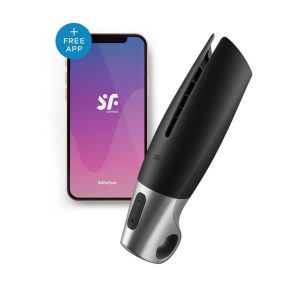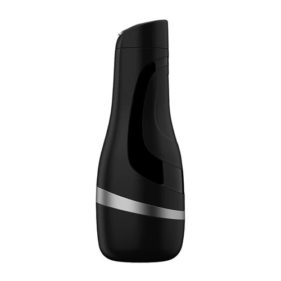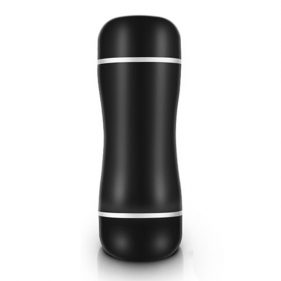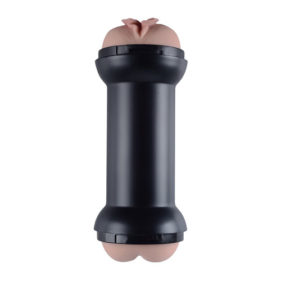
Disclaimer: This article aims to answer the question “What does healthy sperm look like?” and enumerate the signs of unhealthy sperm and tips to prevent those issues from happening. However, this guide is not a substitute for professional medical advice. We strongly recommend visiting a healthcare provider or fertility clinic for a comprehensive semen analysis and personalized consultation.
When a couple faces challenges with conception, it often seems that the woman bears the brunt of the scrutiny, with questions about her health and fertility dominating the conversation. The thing is, healthy sperm is much needed for conception to occur; male fertility issues are just as significant and can equally impact a couple’s ability to conceive.
That’s why male individuals must understand what a healthy sperm look like and signs that may indicate that there’s an issue.
Difference Between Sperm and Semen

Before we discuss the signs of healthy and unhealthy sperm, let’s clear up the difference between semen and sperm. Just like the terms vulva and vagina, these are often used interchangeably, but they actually refer to two different things.
Sperm is a tadpole-shaped male reproductive cell, present to people assigned male at birth. Their main purpose is to fertilize the female egg cell during vaginal sex, in which about 80 to 300 sperm are released during ejaculation or male orgasm.
They have three main parts—a head, midsection, and tail. The head contains chromatin, the DNA material that forms chromosomes. The midsection, also called the body or midpiece, is packed with mitochondria, which provide the energy needed for movement. Lastly, the tail, or flagellum, makes up about 80% of the sperm’s length and drives its movement.
Sperm are invisible to the naked eye; a microscope is needed to examine them. And to move freely and quickly from the vagina to the fallopian tube, they rely on a certain fluid.
That fluid? You guessed it—it’s semen.
Semen is a whitish-gray, gel-like fluid that transports sperm out of the body and into the female reproductive system. Once there, it supports the sperm’s journey toward the egg, potentially leading to fertilization and pregnancy.
It’s produced by the seminal vesicles and prostate gland and primarily consists of water, mucus, and plasma. Small amounts of glucose, cholesterol, lactic acid, citrate, calcium, potassium, magnesium, and zinc are also present.
The sperm is microscopically small, so determining if it’s healthy or not requires a microscope. However, your semen can give out clues if something’s amiss, which is why experts recommend that male individuals check their semen occasionally.
What Does Healthy Sperm Look Like?

To help you check if your sperm is in good shape, you can see that through your semen. Healthy semen typically has a whitish-gray color and a thick, gel-like consistency, similar to body lotion. However, this thick consistency changes after ejaculation; initially, semen is quite thick, but it gradually thins out within 15–30 minutes when exposed to air.
Regarding smell, healthy semen often has a chlorine or bleach-like scent. The taste can vary widely—some find it salty, while others describe it as bitter. This variation in taste is usually influenced by the person’s diet, as certain foods and beverages can subtly alter the flavor.
Signs Of Unhealthy Semen
It’s normal for semen to alter its consistency and taste from time to time, but there are certain signs that you shouldn’t brush off, such as the following:
1Changes in Color

When your semen appears black, pinkish, greenish-yellow, or any color other than grayish-white, it could signal an underlying health issue. We recommend consulting your urologist or healthcare provider right away if you notice these changes, but for reference, here are some possible causes of semen color changes:
Yellow or Yellowish-Green
Age, certain foods (like turmeric, asparagus, and chives), not ejaculating for a long time, medications (rifampin and phenazopyridine), and smoking can cause the sperm to temporarily turn slightly yellow.
However, certain medical conditions can also lead to a yellowish tint in semen. One such condition is urinary retention, where a person cannot fully empty their bladder. When semen passes through the urethra, it may mix with any leftover urine, resulting in that yellowish color.
Another condition that may cause a yellowish tint in semen is prostatitis or prostate infection. This typically occurs when bacteria from the urinary tract infect the prostate gland. Common symptoms include lower abdominal pain, pain during urination, discomfort during orgasm, frequent urination, and fever.
Jaundice can also cause a yellowish tint in semen. This condition is often caused by hepatitis, gallstones, or other related issues, leading to the yellowing of your skin, mucous membranes, and the whites of your eyes. So, if you notice your skin is getting yellowish and feel chills or abdominal pain, see a doctor immediately.
There are also sexually transmitted infections that could cause yellow-green semen, like chlamydia, genital herpes (herpes simplex 2 or HSV-2), and gonorrhea.
Pink, Red, or Brown
If your cum has a pinkish-red or orange-brown tint, it might indicate blood in your semen or hematospermia.
Don’t panic yet. This doesn’t necessarily mean something serious is going on. Often, that reddish or brownish tint can result from a small blood vessel bursting during orgasm, much like what happens with a nosebleed. However, if you notice changes in your semen color along with other symptoms, it’s important to consult your doctor right away. The presence of this discoloration can also be linked to an injury in your reproductive system, a seminal tract infection, high blood pressure, STIs like gonorrhea and chlamydia, as well as bacterial or viral infections.
Blood disorders, such as sickle cell disease, and certain cancers—like testicular, prostate, bladder, and seminal vesicle cancer—can also cause this, though it’s worth noting that the cancers are quite rare in these cases.
Black Semen
In most cases, black semen indicates the presence of blood, but this blood is typically old and hasn’t been expelled from your body yet. However, certain studies found other causes.
One study linked black semen to spinal cord injuries, as these injuries can cause the seminal vesicles—responsible for sperm production—to malfunction. There’s also a 2013 study discovering that exposure to heavy metals like manganese, lead, and nickel can lead to dark-brown semen.
-
₱750.00
-
₱6,245.00
-
₱11,526.00
-
₱1,490.00
2Watery Consistency

Yes, semen does tend to thin out a few minutes after ejaculation, but if it’s extremely watery right after orgasm, it could be a sign of low sperm count, known as oligospermia. A fertile male typically releases between 80 to 300 million sperm per ejaculation, while anything fewer than 15 million in each millimeter is considered low.
Low sperm count doesn’t mean you can no longer conceive; it just means you might face extra challenges compared to someone with an average sperm count. That’s why it’s best to talk to your doctor so that you’ll be able to take the needed treatment options and increase your sperm count.
Apart from low sperm count, watery semen can also result from frequent ejaculation (gel-like consistency is usually still present even if it’s thinner) or zinc deficiency.
In some cases, you might not have actually ejaculated yet and are instead releasing pre-cum, or pre-ejaculation fluid, which typically contains fewer sperm. This fluid serves to neutralize the acidity in the urethra and provide extra lubrication during the deed.
3Doesn’t Liquify After Air Exposure

If your semen is extra clumpy or hasn’t liquefied (thinned out) after being exposed to room temperature for an hour, that can be concerning.
The liquefaction of semen is important for conception, as it allows sperm to swim more easily into the fallopian tubes. So, if your semen is clumpy or didn’t liquefy an hour after ejaculation, it means the sperm might have a harder time reaching the egg.
-
₱5,395.00
-
₱2,455.00
-
Original price was: ₱784.00.₱548.80Current price is: ₱548.80.
-
₱6,045.00
4Foul Odor

Semen typically smells like bleach, chlorine, or ammonia. There might be subtle changes occasionally, but if it has become pungent, like fish or rotten eggs, there might be an underlying issue such as sexually transmitted infections (trichomoniasis, gonorrhea) or prostatitis.
5Semen Volume is Extremely Low

As you age, the amount of ejaculation that you can release does increase. Still, if it suddenly becomes too low, a health issue might be causing that.
Some of the potential causes are retrograde ejaculation (the sphincter responsible for keeping the semen out of the bladder didn’t work), erectile dysfunction (difficulty in keeping an erection), ejaculatory duct obstruction, hypogonadism, and other similar conditions.
Tips to Keep Your Sperm Healthy
After learning what healthy sperm look like and the signs of unhealthy sperm, you may be concerned about maintaining your sperm health over the long term. The good news is that there are plenty of straightforward ways to keep your sperm healthy. Here are some tips to get you started:
1Maintain a healthy lifestyle.

When your body is in good health, it positively impacts every aspect of your well-being, including the quality of your sperm. That’s why this tip is first on the list. If you’re currently overweight, not exercising, not having enough sleep, putting yourself under multiple stressors, and focusing on unhealthy mechanisms, there’s a big chance that your body will develop health issues, which then affect your sperm quality and fertility.
Take a moment to evaluate what aspects of your lifestyle could improve. Regarding your diet, prioritize nutritious foods such as vegetables, fruits, eggs, chicken, fish, and whole grains. Also, try incorporating foods rich in Vitamin B-12, Lycopene, and Vitamin C into your diet; these foods are known to boost fertility.
Moving from the diet, you’ll also need to be more active. Various studies show that regular movement can boost your sperm count. Plus, the hormones released during exercise can boost your sex drive, which means more intimate moments with your partner—definitely a plus if you’re trying to conceive!
You don’t need an elaborate plan; even simple activities like gardening and household chores can make a difference. However, be mindful not to overdo it. Excessive exercise has been linked to reduced semen quality due to the physical and psychological stress that intense workouts can impose.
Make sure you’re getting enough rest and treating yourself to something sweet now and then. When stress takes over, it doesn’t just affect your mood—it can impact sperm health, too. A highly restricted diet, intense workouts, or missing at least 7 hours of sleep can all add to your stress, so try to keep a balanced approach in mind.
-
₱1,745.00
-
₱1,215.00
-
₱1,215.00
-
Original price was: ₱19,995.00.₱9,997.50Current price is: ₱9,997.50.
2Steer clear of smoking, excessive drinking, and other vices.

Let’s be real—most of us have a few go-to vices to cope with life’s daily stress, whether it’s that third cup of iced coffee, a drink at the bar, or even vaping or cigarettes. Here’s the catch, though: these habits can affect sperm quality.
Research has shown that caffeine can damage sperm DNA, while weekly consumption (five or more units) of alcohol use can lead to lower sperm count and motility. So, if you’re trying to conceive and facing some challenges, consider cutting back on some (or even better, all) of these habits.
3Opt for loose-fitting underwear, though it’s not mandatory.

There’s a common belief that wearing tight underwear, like jockeys or briefs, can raise the temperature of the testicles and lower sperm count.
A 2016 study found no difference in sperm count between men wearing briefs and boxers. However, a 2018 study suggested the opposite, noting that men who wore boxers had 17% higher sperm counts than those who wore briefs. The researchers pointed out that the study was inconclusive since they couldn’t measure other factors that could affect sperm count.
So, when it comes to underwear, go with whatever feels comfortable. As long as you’re changing it daily, it’s breathable cotton, and it’s the right size, you’re good to go.
4Limit exposure to certain chemicals.

If you work in factories or industries where you’re exposed to chemicals, it’s important to be cautious around hormone-disrupting chemicals, which the CDC refers to as reproductive hazards.
These sperm-affecting substances include lead, carbaryl (Sevin), mercury vapor, dibromochloropropane, styrene, and acetone. Regular exposure to these chemicals can potentially lead to lower sperm count, abnormal sperm shape, and decreased sexual performance. For more details, check out the study linked here.
-
₱3,395.00
-
₱3,395.00
-
₱995.00
-
₱995.00
5Take supplements that are good for male fertility.

While this step isn’t mandatory, consider incorporating supplements known to increase sperm count and improve sperm quality. These include:
- Vitamin C – Protects sperm from oxidative stress
- Vitamin D – Boosts your testosterone
- Selenium – Good for sperm production; increase sperm motility
- L-Carnitine – Provides extra energy for sperm
- Coenzyme Q10 – Enhances semen quality
- Ashwagandha root extract – Can increase sperm count
- Zinc – Can increase sperm count
If you have chronic conditions or want to be cautious, consult with your doctor, especially if you plan on taking more than one pill.
Takeaway
Keeping your sperm healthy isn’t just important for conception; it can also help you steer clear of other health issues. Since you can’t see your sperm, you’ll need to pay attention to your semen for any changes that could signal a problem. If you notice anything unusual in color or texture, don’t hesitate to talk to your healthcare provider about it.
Adopting a healthy lifestyle can also work wonders. Consider cutting back on vices like smoking or taking supplements that can support your sperm health. Small changes can lead to big improvements, so take it one step at a time.


















